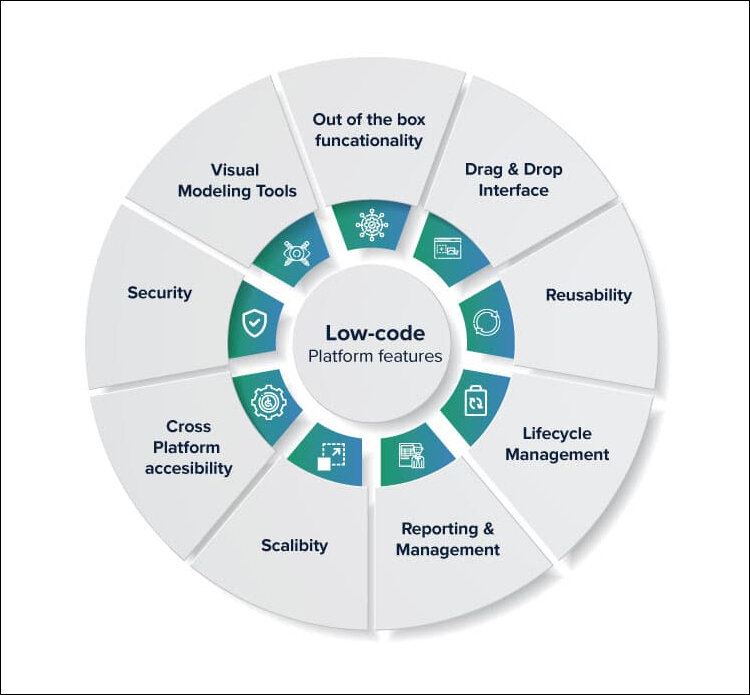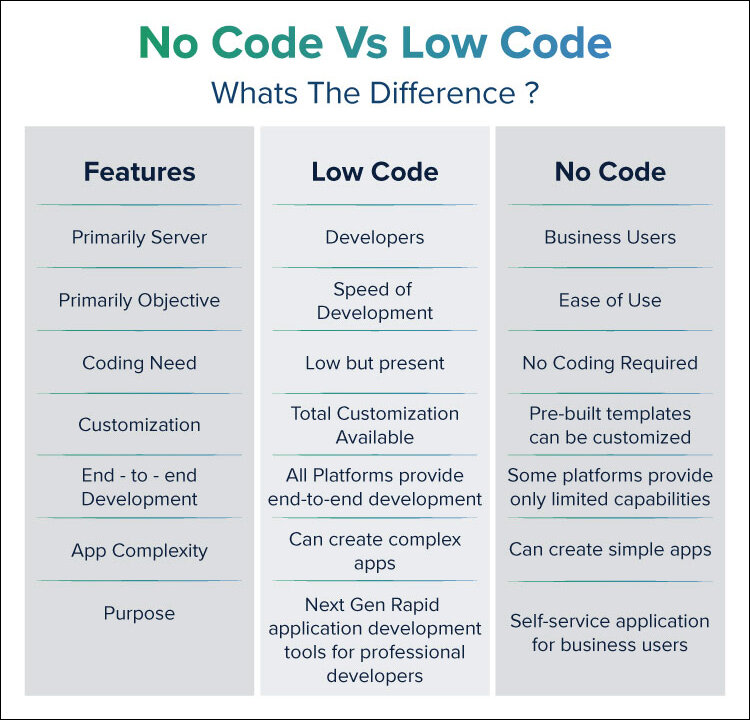It’s important to approach no-code platforms, like anything else, with a balanced perspective.
Introduction:
In an era defined by rapid technological advancements, new buzzwords and concepts emerge at an unprecedented pace. One another term that has recently garnered attention is “no-code.” While this term may sound appealing to those seeking simplified technological solutions, it is imperative to critically examine its implications.

Misleading Terminology explained
The term “no-code” presents a simplified view of software development that may be alluring to non-technical users. However, it is essential to recognize the inherent limitations and potential pitfalls associated with this approach. By critically evaluating the term and considering alternative options, there is a very important view to take decisions that align with long term needs and goals.
Currently, the task of ‘creating a website’ has become simplified, thanks to technologies that enable the easy construction of user interfaces (UIs). However, complex contexts necessitate proficiency in coding skills for effective development. No-code comes with this share of pit-falls.
- Limited Functionality:
While no-code platforms offer a simplified user interface and drag-and-drop functionality, they come with inherent limitations. These platforms often lack the flexibility and customization options available in traditional coding environments. As a result, users may face difficulty in implementing complex features or integrating with external systems, limiting the scope of their projects.
- Lack of Control:
By using no-code platforms, users surrender a degree of control over their digital creations. These platforms are often proprietary, meaning that users have limited access to the underlying codebase. This can hinder users’ ability to troubleshoot issues, make modifications, or maintain their projects in the long term. Following a template’s structure can hinder creativity, stifling the emergence of novel ideas due to a lack of need to invest time and effort in creating scratches.
- Vendor Lock-In:
When users rely on no-code platforms, they become dependent on the specific vendor’s services. This creates a form of vendor lock-in, where users are constrained to the platform’s limitations and pricing structures. Switching to a different platform or migrating projects may require significant effort and additional costs.
- Security and Privacy Concerns:
No-code platforms are often hosted on third-party servers, raising concerns about data security and privacy. Users may have limited control over where their data is stored and processed, leaving them vulnerable to potential breaches or unauthorized access as well.

So is it all that bad?
While it is not all doom and gloom, it is important to look at options before jumping in and take a balanced view of any technological jargon.
Develop Coding Skills:
Cultivating basic coding skills is valuable, even for non-technical users, as it enhances comprehension of software and project control.
Explore Open Source Solutions:
Open source software offers an alternative to proprietary no-code platforms, granting users access to the source code for customization and maintenance.
Consult with Experts:
For complex projects or challenges, consulting experienced software developers or IT professionals is beneficial. They offer guidance, identify potential risks, and suggest suitable solutions, ensuring a smoother and more effective development process.
Embrace Low-Code:
Consider low-code platforms for a balance between ease and customization. They offer visual programming environments to build applications without extensive coding. Some of the good alternatives are as below

1. Salesforce Platform:
- One of the most well-known low-code platforms, Salesforce offers a comprehensive suite of tools for building CRM (Customer Relationship Management) applications.
- With features like drag-and-drop development, pre-built components, and AI-powered insights, Salesforce enables businesses to create custom applications tailored to their specific needs.
2. Zoho Creator:
- Zoho Creator is a low-code platform that provides a wide range of features for building a variety of applications, including database management, workflow automation, and custom reporting.
- It offers an intuitive interface, pre-built templates, and integration with other Zoho products, making it suitable for businesses of all sizes.
3. Appian:
- Appian is a leading low-code development platform known for its ability to create complex enterprise applications.
- With a focus on business process management (BPM) and workflow automation, Appian provides a powerful set of tools for designing and deploying custom applications that can streamline operations and improve efficiency.
4. Mendix:
- Mendix is a low-code platform specifically designed for building mobile and web applications.
- It features a user-friendly interface, pre-built templates, and integration with popular development tools, making it a popular choice for developers and citizen developers.
5. OutSystems:
- OutSystems is a low-code platform that emphasizes rapid application development.
- With a focus on productivity and scalability, OutSystems enables developers to create and deploy applications quickly while maintaining high-quality standards.

No-code or Low-Code or All-Code or Hybrid?
The term “no-code” or any other terminology can be misleading, as all software development involves some form of coding, whether it’s through traditional programming languages or visual programming environments. This dichotomy that coding is either essential or unnecessary is false. Technology companies may inadvertently mislead users who lack a fundamental understanding of software development by perpetuating the illusion of “no-code.” In reality, every aspect of software development or product development, from orchestrators, product owners, planners to analysts and coders, is essential. What ‘no-code’ does is that it makes the framework accessible for non-technical folks. Regardless of the development methodology used (Agile or Waterfall), even the most basic server setup requires low-level system coding language to establish the hardware infrastructure. Over time, this system can leverage object-oriented programming and accumulated knowledge to generate intelligent patterns based on widgets.
Solution and Enterprise architects based on their experience are required to make informed decisions by examining alternatives to “no-code” and embracing a realistic understanding of software development methodologies that can scale to the requirements.
It’s important to approach no-code platforms, like anything else, with a balanced perspective. While they can be a great starting point for creating basic applications, complex systems may require a combination of no-code and coding skills to achieve the desired level of customization and functionality.
In case you missed:
- Misnomers in the Computing World – Part 1 (Serverless Computing)
- ‘Cloud-ed’ Decisions
- What Are GPT Stores Really?
- Is Agile Dying?
- End of Freebies
- Social Media Applications.. Have They Peaked?
- What is AI going to cost us?
- Convergence Digital and Real – Is It Good
- Technology to End Sexual Violence
- AI and Opening up the Banks









